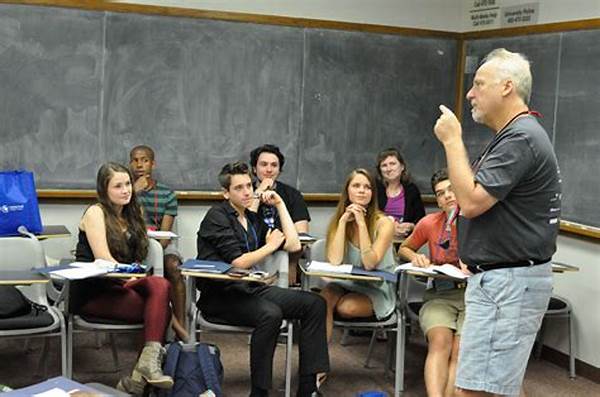Once upon a time, in a school not unlike the ones we know today, a humble teacher named Mrs. Johnson embarked on a quest. Her mission was far more than educating students; she aimed to captivate their imaginations, to turn the ordinary classroom into a realm of dramatic exploration. Through passion, creativity, and an array of classroom theater directing strategies, she transformed her lessons into performances worth remembering.
Read Now : Iconic Albums With Hit Singles
The Power of Imagination in the Classroom
In her narrative, Mrs. Johnson discovered the profound impact of theatrical elements on student engagement. As the curtain rose on her makeshift classroom stage, the magic of theater unfolded. Mrs. Johnson’s classroom theater directing strategies were like a masterful symphony of creativity and pedagogy. With every lesson, she wielded these strategies to guide her students through worlds of wonder and curiosity.
First, each class began with a story—a tale crafted to draw students into a new lesson. These stories became the cornerstone of Mrs. Johnson’s approach, demonstrating how narratives can transform abstract concepts into vivid, relatable experiences. Her classroom theater directing strategies emphasized not only the art of storytelling but also the involvement of students in the narrative creation process. Students were no longer passive learners; they became active participants, actors in their own educational play, thus making their learning journey memorable.
Techniques for Effective Classroom Theater Directing
1. Story-based Scripting: Begin each lesson by composing a story that aligns with the topic. These classroom theater directing strategies create a framework for the day’s lesson.
2. Character Assignments: Assign roles to students, allowing them to explore the subject matter’s depth. These practices within classroom theater directing strategies help build empathy and understanding.
3. Interactive Performances: Turn class discussions into plays. These classroom theater directing strategies encourage participation and enhance comprehension.
4. Setting the Scene: Transform the classroom space into various thematic settings. These classroom theater directing strategies stimulate sensory engagement.
5. Narrative Reflections: After performances, discuss the storyline and its lessons. Such classroom theater directing strategies refine critical thinking.
Building a Theatrical Environment
Mrs. Johnson understood that the environment played a crucial role in her classroom theater directing strategies. She believed in creating a vibrant, dynamic setting that could shift as easily as the scenes in a play. The classroom became an arena for stories—a place where the world outside faded away and a new realm came to life.
Fostering this environment required ingenuity and dedication. Mrs. Johnson rearranged desks, sourced props, and designed backdrops to fit the theme of each lesson. These physical transformations encouraged students to push the boundaries of their creativity. Her classroom theater directing strategies inspired students to see beyond the four walls and into the worlds they could create and explore. The classroom, once a static setting, turned into a living, breathing part of the educational experience.
The Role of Improvisation
Improvisation became an ally in Mrs. Johnson’s toolbox of classroom theater directing strategies. She found that allowing room for spontaneity opened doors to unplanned learning moments. Through improvisational exercises, students learned to think on their feet, react to the unexpected, and weave their own narratives using core lesson concepts.
Read Now : Developing Mutual Respect In Ensembles
Improvisation taught students the value of flexibility and adaptability, invaluable skills both in theater and life. These techniques formed a bridge between theoretical learning and practical application, enabling students to craft their learning journeys. Mrs. Johnson’s classroom theater directing strategies demonstrated the power of improvisation as a catalyst for creativity and a testament to the evolving nature of education.
Crafting Stories that Resonate
Mrs. Johnson’s greatest tool, however, was her ability to craft stories that resonated. Her classroom theater directing strategies required her to dive deep into the curriculum and extract the human element within each lesson. Through narrative, facts became emotions, and data became stories that lingered in the hearts of her students long after the final bell had rung.
Every story she penned was a vessel carrying the essential teachings of the day. Her students, in becoming part of these stories, found themselves learning more than just academic content. They discovered lessons on courage, empathy, resilience, and creativity. Mrs. Johnson’s classroom theater directing strategies taught them to see the world through different lenses, to appreciate the tapestry of human experiences.
Creating the Individual Experience
Central to classroom theater directing strategies was the individual experience—each student a unique player with a distinct role. Mrs. Johnson believed that while theater brought students together, it also allowed them to bring forth their personal narratives. Each performance was a celebration of diversity, as students infused their characters with personal touches that spoke to their experiences.
Building these individual experiences required trust and encouragement. Mrs. Johnson created a safe, inclusive environment that embraced every contribution as valuable. Her classroom theater directing strategies empowered students to voice their thoughts, interpret roles uniquely, and approach challenges creatively. These performances became a tapestry woven from the threads of diverse perspectives, rich in color and depth.
The Legacy of Classroom Theater Directing
Mrs. Johnson’s legacy radiated long after her students had left the classroom. The skills instilled through her classroom theater directing strategies remained with them as they ventured into the world. Former students would reminisce about those transformative lessons where they were both spectators and stars in their educational journey.
Her classroom was more than a place of learning; it was where the seeds of imagination were sown. Through her classroom theater directing strategies, Mrs. Johnson imparted a lifelong love for learning, curiosity, and creativity. Each student carried a piece of that magic, empowered to view life as a stage where they held the power to script their narratives.
